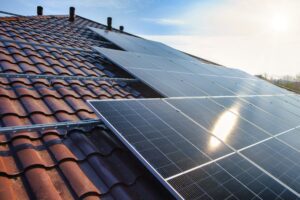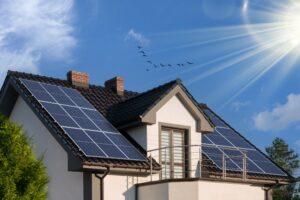As the world increasingly embraces renewable energy, many homeowners are considering the shift to solar panels as a sustainable and economically beneficial option. However, the journey towards solar energy starts with evaluating the suitability of your roof and whether or not installation of a solar array is even feasible for you right now.
Various factors, such as orientation, structure, and material of your roof, play a crucial role in determining its compatibility with solar panel installation. This article aims to guide you through these considerations, ensuring that your move towards solar energy is both practical and efficient.
- Create a Tailored Quote Based On Your Circumstances
- Takes Less Than 2 Minutes
- Fixed-Online Quotes

Roof Orientation
A south-facing roof is typically the most optimal choice for solar panel installation due to its prolonged exposure to the sun’s rays at their most intense time of day. This orientation ensures that solar panels can absorb the maximum amount of sunlight throughout the day, translating into higher energy generation.
However, this doesn’t by any means exclude east and west-facing roofs from being suitable candidates. A south-facing roof is the gold standard and means your house is most suitable for solar panels, but that’s not your only option.
East-facing roofs capture the morning sun, making them efficient during the first half of the day. Naturally, this means a west facing roof is more effective in the latter half, absorbing the afternoon and evening sunlight – which is typically better quality for solar panels allowing them to generate solar electricity more efficiently.
Although they might not achieve the peak efficiency of south-facing installations, east and west facing roofs still offer substantial solar energy collection potential, making them perfectly viable options for homeowners looking to harness solar power.
A north-facing roof is not a great option at all, however, and will almost certainly prove to be ineffective. An east-facing roof is a less ideal roof orientation than a west-facing roof, and rooftop solar panels may not be the optimal choice here either. Perhaps a ground mounted solar PV system would be better for north and east-facing roofs.
This adaptability in orientation allows more homes to benefit from solar technology, despite varying architectural designs and geographical settings.
Roof Pitch
The ‘pitch’ of a roof refers to its angle of slope. When it comes to being suitable for solar, the ideal angle is between 30 to 40 degrees. This specific range is considered optimal because it allows the panels to absorb the maximum amount of sunlight, enhancing their energy-generating efficiency throughout the day.
Before you climb up to your roof with a protractor, understand that solar panels can still be effective even if the roof pitch falls outside this ideal range! However if the pitch is less than 12 degrees (e.g. flat roofs), the solar panels installed there are more likely to gather dirt and debris, which can obstruct sunlight and reduce their efficiency. For this reason, we don’t currently install solar panels on a flat roof.
However, it is possible for solar panels to be installed with a mounting system for flat solar panels. This places them at a suitable angle for solar electricity generation, although having a roof with the right pitch is usually the most cost effective and efficient option.
Roof Size and Layout
As a rule of thumb, for a 4kW solar system, you would need approximately 28 square meters of clear, unobstructed roof space. Clean roof space is a must, too. This space requirement ensures that a sufficient number of panels can be installed to achieve the desired power output.
It’s crucial to consider any potential obstructions on your roof, such as skylights, roof vents, chimneys, or even architectural features like turrets. These elements can not only complicate the layout of the solar panels but also potentially increase the installation costs due to the additional work and equipment needed to navigate around them.
For this reason, a really thorough assessment of your roof’s layout and available space is essential in planning an effective solar panel installation. We can conduct a free in-person or remote solar survey to help determine if your roof is suitable for solar panels.
Shade And Sun Exposure
Heavy shading over your roof can have a notable impact on the performance of solar panels. Direct sunlight is the most important factor in order to generate electricity.
Shade from trees, buildings, or other structures can significantly reduce the amount of sunlight reaching the panels, thereby diminishing their energy output and efficiency.
In extreme cases, consistent shading can even lead to physical damage to the panels. Professional solar installers can conduct a detailed shading analysis of your property to determine the best solution for you.
Roof Material And Strength
Solar panels can be installed on a wide range of roofing materials, making them versatile for various home styles. Common materials like asphalt shingles and metal are particularly well-suited for solar installations due to their durability and ability to support the weight of the panels. Glass roofs, on the other hand, are unlikely to be suitable.
At the end of the day, the overall strength and integrity of the roof is the most important consideration. If a roof is older or showing signs of wear, installers may advise reinforcing it to ensure it can safely support the solar panels. This reinforcement helps prevent potential structural issues and extends the longevity of both the roof and the solar installation.
It’s important for homeowners to have a professional assessment of their roof’s condition before proceeding with solar panel installation, to ensure both safety and effectiveness.
Can You Install Solar Panels on Thatch Roofs?
Installing solar panels on alternative roofing materials, such as thatch, presents unique challenges and considerations. Thatch roofs, with their traditional and often historical significance, require careful handling to preserve their integrity.
The primary concern is the weight and installation method of solar panels, as thatch is generally not as robust as conventional roofing materials like tiles or metal. Special mounting systems may be needed to distribute the weight evenly and avoid damaging the thatch.
Additionally, the fire safety aspect is crucial, given the combustible nature of thatch. Integrating modern solar technology with these traditional roof materials demands a bespoke approach, often involving specialised installers who can navigate these complexities while adhering to local building regulations and preserving the roof’s aesthetic and functional characteristics.
Regulations And Permissions
In most cases, homeowners looking to install solar panels don’t need to worry about obtaining planning permission, which simplifies the process significantly. This ease of installation is part of the appeal of solar energy systems for residential use.
As always, there are exceptions to this rule, particularly in a conservation area or for listed buildings. In these cases, the aesthetic or historical significance of the area or building means that any alterations, including the addition of solar panels, might require special approval.
Therefore, it’s important for homeowners in these specific situations to check with their local planning authority before proceeding with installation, to ensure compliance with any regional regulations or guidelines.
How To Assess If Your Roof Is Suitable For Solar Panels?
Assessing your roof’s suitability for solar panels yourself is probably not a great idea, as you’ll need a professional opinion to ensure that not only is your roof suitable, but that your roof is actually safe for a solar panel installation.
Effective Home can help conduct a thorough survey to check if solar panels are appropriate for your home. A free, in-person or remote survey from a professional member of our team will ensure you have all the information you need to decide if investing in solar is right for you.
We’ll gather key information about your roof:
| Orientation of roof: | We’ll check if your roof is north, east, south, or west-facing, which will help determine if solar panels can realistically be installed on your roof with suitable results. |
| Pitch of your roof: | Our expert will check if you have the right roof pitch for solar panels. If you do, great, and if you don’t then we’ll see if we can figure out a mounting system that will allow you to achieve the appropriate pitch. |
| Size of your roof and layout: | You can have the right roof size for solar panels, yet still have structural elements that are in the way, making your roof’s layout difficult to work with. Our solar design team is used to creating clever work-arounds, but sometimes a roof is simply not suitable. We’ll always be honest with you about whether yours is or not. |
| Realistic sun exposure: | This is really important for us to review, which is why we’ll look out for potential shading problems when reviewing your roof. Is there a growing tree in your neighbours garden? Does that tall apartment building at the back of your house cast a shadow during the mid-afternoon? This all needs accounting for. |
| Material of your roof: | Roof material is a huge factor. If you know your roof material, you can let us know, but if not, we’re experienced with a range of roof materials and know which are best suited to solar panels. |
| Condition of your roof: | And finally, perhaps the biggest factor of all – roof condition. We’ll assess your roof to ensure it’s structurally sound enough to support the significant weight of a solar panel system. |
We’ll complete all of these assessments as part of our survey, so at the end of it you’ll not only know if your roof is suitable for solar panels, but we’ll also design a system for you based on your annual household energy usage, tell you what you’ll save if you go solar, and provide you with a free no-obligation quote.
It’s worth reaching out to our expert team today.
Summary
While many roofs can accommodate solar panels, it’s important to consider orientation, pitch, size, shading, material, and regulatory requirements for a new solar panel system. If unsure, consult our experts for a detailed roof survey and electricity generation projections.
Investing in solar panels not only contributes to a greener planet but also offers significant financial and environmental benefits. So get in touch today, reduce your electricity bills and lower your carbon footprint!
References
- Solar Guide. (n.d.). Is My Roof Suitable for Solar Panels? Retrieved from https://www.solarguide.co.uk/roof-suitable-for-solar-panels
- Energy Saving Trust. (2021). Solar panels. Retrieved from https://energysavingtrust.org.uk/advice/solar-panels/
- U.S. Department of Energy. (n.d.). Planning a Home Solar Electric System. Retrieved from https://www.energy.gov/energysaver/planning-home-solar-electric-system
- Solar Energy Industries Association. (n.d.). Solar Industry Research Data. Retrieved from https://www.seia.org/solar-industry-research-data
- Create a Tailored Quote Based On Your Circumstances
- Takes Less Than 2 Minutes
- Fixed-Online Quotes




